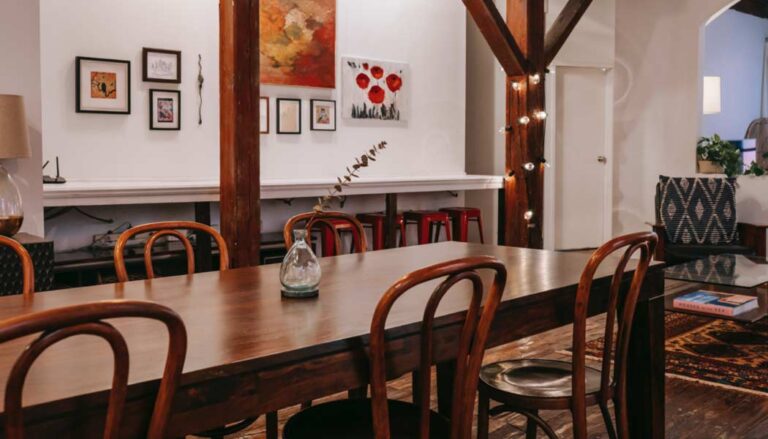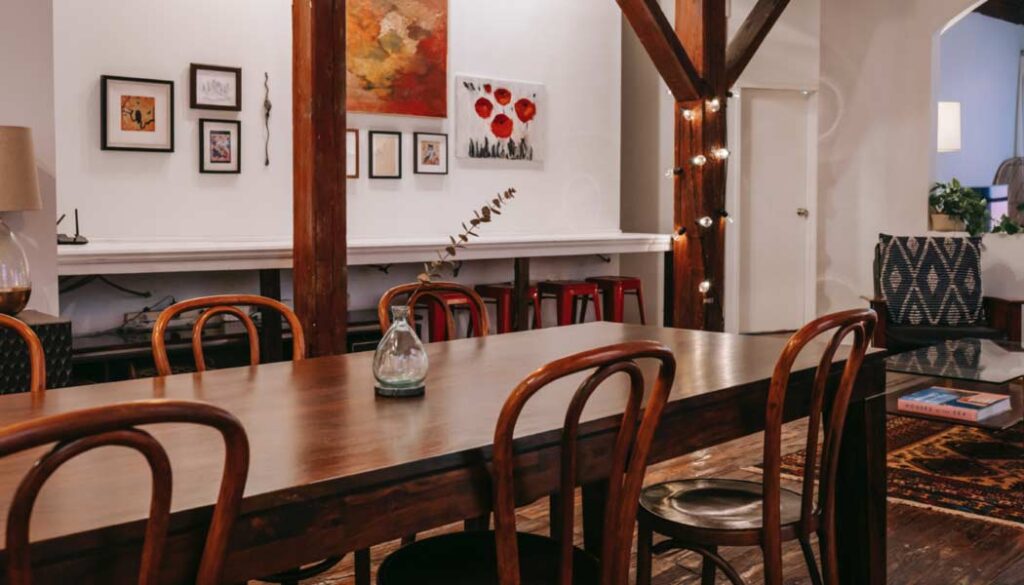
Can You Use Acrylic Paint on Wood Table?
Acrylic paint can be used on a wood table. It provides good adhesion and durability when properly prepared and sealed with a clear finish.
Hey there, art enthusiast! Ever looked at a plain wooden table and thought about turning it into a colorful masterpiece? Let’s explore using acrylic paints on wood tables in this guide.
Acrylics are like magic for artists – they dry fast, offer rich pigments, and stick to various surfaces. But what happens when acrylic paint meets a wooden table? Can you create something amazing?

In this article, we’ll uncover the secrets of using acrylic paint on wood tables. We’ll check out the steps, materials you’ll need, and tips to make your painted table a true work of art. Whether you’re a seasoned painter or just starting, get ready to transform your space with acrylics and wood.
Can You Use Acrylic Paint on Wood Table?
You can use acrylic paint on a wood table. It’s a fantastic way to add color and creativity to your table while enjoying the benefits of acrylic’s fast-drying and adhesive properties. Just follow some basic steps to ensure a successful and durable outcome.
You might have a wooden table that’s begging for a fresh look, in that case, you can use acrylic paint to give it a colorful makeover! Acrylic paint isn’t just for canvases at all. It’s a versatile medium that can work wonders on wood too.
Acrylic paints’ magic lies in its ability to adhere to various surfaces. Wood is no exception. With a little bit of prep and a whole lot of creativity, you can transform that table into a unique piece of functional art. First things first, though – make sure the table’s surface is clean and smooth. Light sanding can do wonders by creating a paint-friendly texture.
Now, onto the fun part! Pick your acrylic paints in all the shades that speak to your style. Whether you’re into bold and bright or subtle pastels, the choice is yours. Express yourself! Feel free to sketch out your design lightly if you’re feeling a bit cautious.
As you apply the paint, watch the magic unfold. Acrylics dry relatively quickly, so you won’t be left twiddling your thumbs for long. Layer the colors, blend them, or let them stand out independently – it’s your artistic playground.
Once your masterpiece is dry, you might want to consider adding an extra layer of protection. You can do it with a clear acrylic sealer. This not only preserves your artwork but also gives it a glossy, professional look.
So, there you have it – a wooden table turned into a canvas for your creative spirit. Get ready to impress your guests with a piece of functional art that reflects your style and flair. With acrylic paint and a little imagination, the possibilities are limitless!
Also read: Acrylic Paint Washable: What’s the Truth
How to Use Acrylic Paint on Wooden Table?
Before starting to paint, you need to prepare the paint in the following way. After having done so, seal your artwork with clear acrylic sealer. It will increase its durability.
Using acrylic paint on a wooden table is a fun and creative project. Here’s how to do it:
1. Prepare the Surface: Start by cleaning the table surface and sanding it lightly to create a smooth and even texture. This helps the paint adhere better.
2. Gather Supplies: Get high-quality acrylic paints, brushes, water, mixing palette and painter’s tape if you want to create clean edges.
3. Prime if Necessary: If the wood is porous or has a strong grain pattern, consider applying an acrylic primer to create an even base for the paint.
4. Apply Base Coat: Apply a thin, even layer of acrylic paint as a base coat. This can be a solid color or a background for your design. Let it dry completely.
5. Painting: Now, unleash your creativity! Apply your chosen acrylic colors with brushes, sponges, or other tools. Layer the paint for depth and richness.
6. Drying Time: Acrylics dry relatively quickly, but it’s best to wait between layers to prevent smudging. Follow the paint manufacturer’s recommendations.
7. Sealing: Once the painting is dry, consider sealing it with a clear acrylic sealer or varnish. This protects the paint and gives a professional finish.
8. Caring for Your Artwork: While acrylics are durable, use coasters for hot or wet items, and avoid using abrasive cleaners.
Remember, your wooden table can become a stunning canvas for your artistic expression. Have fun and experiment with different techniques to achieve the desired effect.
Is Acrylic Paint Waterproof on Wood?
Yes, acrylic paint is water-resistant on wood, but not entirely water-proof. So it’s wise to seal it with a clear varnish for added protection.
Acrylic paint exhibits water-resistant properties when applied to wood surfaces. It is mostly due to its polymer-based composition. This means that while it can endure light exposure to moisture, it’s not entirely waterproof.
Acrylics form a flexible and durable film as they dry, which helps them withstand damp cloth. However, prolonged exposure to water, heavy rain, or constant humidity could eventually lead to paint degradation. Warping of the wood is also seen in such cases.
To ensure the longevity of your painted wood, it’s advisable to take extra precautions. Applying a clear sealant adds a layer of protection. This sealant creates a barrier between the painted surface and external elements. That is how the paint’s ability to resist water damage is enhanced. As a result, the paint provides a longer-lasting finish.
Can You Use 100% Acrylic Paint on Wood?
Absolutely! You can use 100% acrylic paint on wood with great results. Its strong adhesion and fast-drying nature make it a perfect match for wooden surfaces.
Acrylic paint, renowned for its versatility and vibrant color range, adheres splendidly to wood. Its water-based formulation makes it ideal for transforming wooden objects into eye-catching artworks.
Acrylic paint’s remarkable adhesion ensures that your masterpiece won’t easily chip or peel off the wood. It grants it durability and longevity. The fast-drying nature of acrylics enables you to build layers, blend colors, and work swiftly on your wooden canvas.
The beauty of using 100% acrylic paint on wood lies in its compatibility with a variety of wood surfaces. Additionally, you can apply various techniques to achieve the desired textures and effects.
Remember to seal your artwork with a protective finish. A clear varnish is advisable. This step enhances the colors and shields your creation from potential environmental factors. Thus you can protect your art’s longevity!
In essence, embracing 100% acrylic paint for your wooden projects opens the door to a world of creative possibilities. It’s a dynamic and accessible medium that lets you infuse your wooden surfaces resulting in captivating pieces.
Will Acrylic Paint Stay on Wood?
Certainly! Acrylic paint sticks to wood effectively, offering lasting results. Applying a clear coat can enhance its durability and appearance over time.
Acrylic paint is a fantastic choice for wood surfaces and tends to adhere well. It offers enduring results. The reason behind its impressive staying power lies in its adhesive properties. Acrylic paint creates a robust bond with wood, which helps it maintain its vibrant presence over time.
Acrylic paint forms a flexible yet durable layer that resists chipping and peeling. This quality is especially valuable for surfaces that might experience some wear and tear. Whether you’re crafting intricate designs or applying bold brushstrokes, you can count on acrylic paint to maintain its visual impact.
In essence, acrylic paint’s steadfastness on wood surfaces makes it an artist’s backer. It transforms plain wood into a canvas for your creativity, allowing you to express yourself in a durable and visually pleasing manner. With proper preparation, mindful application, and a protective finish, your projects can become enduring showcases of your artistic skill.
Final Words
In conclusion, using acrylic paint on a wooden table is a definite yes! Acrylics’ adhesion, color range, and quick drying make them perfect for transforming a wooden table into a unique work of art.
Acrylic paint indeed has so many features that make it suitable for wood painting. But you need to perform some procedures. Preparing the paint, and putting it requires your distinct skill. Finally, you are suggested to add sealer to ensure its durability.
Whether you’re a seasoned artist or a beginner, acrylics offer a fulfilling and visually rewarding experience. So, grab your brushes, embrace the colors, and let your table tell a story of creativity for years to come!
